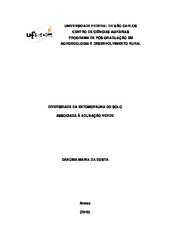Mostrar el registro sencillo del ítem
Diversidade da entomofauna de solo associada à adubação verde
| dc.contributor.author | Costa, Danúbia Maria da | |
| dc.date.accessioned | 2016-06-02T18:57:48Z | |
| dc.date.available | 2013-10-24 | |
| dc.date.available | 2016-06-02T18:57:48Z | |
| dc.date.issued | 2012-11-30 | |
| dc.identifier.citation | COSTA, Danúbia Maria da. Diversity of insects associated with green manure. 2012. 64 f. Dissertação (Mestrado em Ciências Agrárias) - Universidade Federal de São Carlos, Araras, 2012. | por |
| dc.identifier.uri | https://repositorio.ufscar.br/handle/ufscar/160 | |
| dc.description.abstract | The study aimed to assess the diversity of insects associated with green manure, during its development and after its incorporation into the soil. Was conducted in the period from january to June 2011 and driven at the center of agricultural sciences of UFSCar, municipality of Araras - SP (Latitude 22° 2125 South and a Longitude 47° 2303 West), in an experimental area Red-yellow latosol, a Glebe of 1344m ², outlined by 24 plots, entered into four block design with six treatments each, composed of crotalaria (Crotalaria spectabilis); millet (Pennisetum glaucum) and velvet bean (Mucuna aterrima) black plus with organic compound. The plots used for each treatment were 8, 0 m x 7 m (57.2 m2), and the spacing between plots within each block were of 3.0 metres. The solo collection for analysis comprised on the layer of 0 to 20 cm depth. The insects were captured every two weeks, through the pitfalls of type "pitfall", which remained at fixed points within each block, during the development of the live cover and mulch. We collected a total of 17595 individuals distributed in 8 orders, 62 families. Formicidae was the family of dominant insects during the vegetatives stadium of green manures and after its management in soil with mulch. Among the insects, predators, decomposers dispersers and herbivores, the treatments that were grown three different species of green manures presented higher diversity of insects. The use of organic compound in planting green manures not influence on productivity of the same, however, the rate of decomposition of mulch was less over 45 days. | eng |
| dc.format | application/pdf | por |
| dc.language | por | por |
| dc.publisher | Universidade Federal de São Carlos | por |
| dc.rights | Acesso Aberto | por |
| dc.subject | Adubação verde | por |
| dc.subject | Inseto | por |
| dc.subject | Agroecossistemas | por |
| dc.title | Diversidade da entomofauna de solo associada à adubação verde | por |
| dc.title.alternative | Diversity of insects associated with green manure | eng |
| dc.type | Dissertação | por |
| dc.contributor.advisor1 | Margarido, Luiz Antonio Correia | |
| dc.contributor.advisor1Lattes | http://lattes.cnpq.br/5685663057214334 | por |
| dc.description.resumo | The study aimed to assess the diversity of insects associated with green manure, during its development and after its incorporation into the soil. Was conducted in the period from january to June 2011 and driven at the center of agricultural sciences of UFSCar, municipality of Araras - SP (Latitude 22° 2125 South and a Longitude 47° 2303 West), in an experimental area Red-yellow latosol, a Glebe of 1344m ², outlined by 24 plots, entered into four block design with six treatments each, composed of crotalaria (Crotalaria spectabilis); millet (Pennisetum glaucum) and velvet bean (Mucuna aterrima) black plus with organic compound. The plots used for each treatment were 8, 0 m x 7 m (57.2 m2), and the spacing between plots within each block were of 3.0 metres. The solo collection for analysis comprised on the layer of 0 to 20 cm depth. The insects were captured every two weeks, through the pitfalls of type "pitfall", which remained at fixed points within each block, during the development of the live cover and mulch. We collected a total of 17595 individuals distributed in 8 orders, 62 families. Formicidae was the family of dominant insects during the vegetatives stadium of green manures and after its management in soil with mulch. Among the insects, predators, decomposers dispersers and herbivores, the treatments that were grown three different species of green manures presented higher diversity of insects. The use of organic compound in planting green manures not influence on productivity of the same, however, the rate of decomposition of mulch was less over 45 days. | por |
| dc.publisher.country | BR | por |
| dc.publisher.initials | UFSCar | por |
| dc.publisher.program | Programa de Pós-Graduação em Agroecologia e Desenvolvimento Rural - PPGADR-Ar | por |
| dc.subject.cnpq | CIENCIAS AGRARIAS | por |
| dc.contributor.authorlattes | http://lattes.cnpq.br/6657940845587233 | por |
